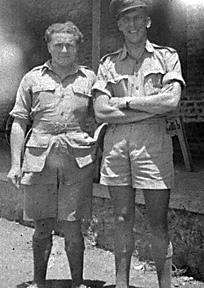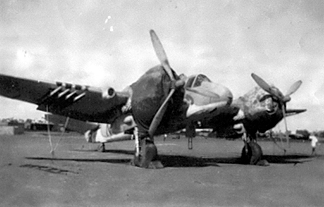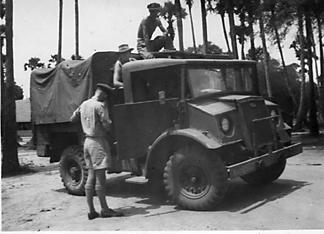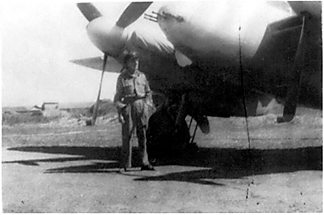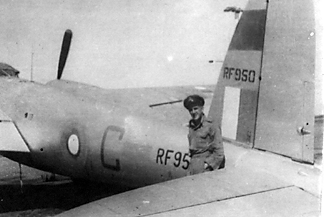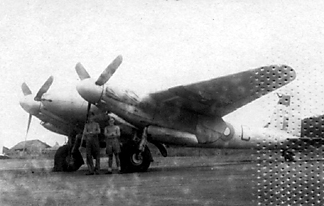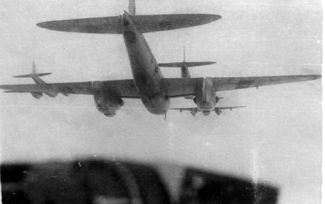 |
 |
||||||||
|
F/O DE Winton 163214 RAFVR Passing up entrance to Cambridge University, Douglas Winton joined the RAF in the early 1940s. From ITW in Cornwall, at RAF Sywell he was “selected for aircrew” and overseas training under the Empire Air Training Scheme. From his Rhodesia Air Training Group EFTS course, he moved on to 21 SFTS Kumalo near Bulawayo to win his wings in September 1944. A General Reconnaissance course followed with 31 Air School at George in South Africa, Winton passing in both Advanced and Astro Navigation.
At Nicosia in Cyprus, No 79 Operational Training Unit had been established in February 1944 to train general reconnaissance and strike crews, though it was May 1944 before training began (a result of the state of the airfield and consequent delays in taking aircraft on charge). The unit operated a typically mixed bag of Blenheim Vs (for initial conversion to twin engine operations), Beaufighters (Mark I, VI, and X), Ansons, and other support aircraft. There, in the usual fashion, Winton teamed up with his navigator 1602102 F/Sgt Basil Salkeld on No 23 Course starting 22 January 1945, for the final polish before their operational squadron posting. In the absence of a dual control Beaufighter mark, the OTU course involved twin-engine experience in the miserable Bisleys, followed by a long “under the hood” session in the Beaufighter cockpit until the pilot could automatically find all the knobs, taps, levers and dials. Only then, with all the power of the Beaufighter ready to hand, were the crews at last free to take to the air. From Cyprus, instead of a spot of home leave F/O Winton and F/Sgt Salkeld proceeded straight to South East Asia Command and the Ranchi SLAIS ground attack school, completing the month long course in early July 1945 with an additional 26 hours Beaufighter experience that were not without incident.
On 15 June 1945, Doug crash-landed ‘N’ at Bishnupur, the local maintenance and service unit. The landing was wheels-up, as the undercarriage would not pump down manually, nor would repeated steep dives free it. In the back seat, the unflappable Salkeld was stoic throughout, remarking after the dust settled that it was the best 3-pointer Winton had done. In late July 1945, the pair moved on to 1672 Conversion Flight, Yelahanka. There they completed the 6 hour Mosquito conversion course in short order, signed out on 2 August by the CO, W/Cdr Blair. In August 1945, Doug and his navigator joined 211 Squadron at St Thomas Mount as part of a draft of ten crews - the last to join the Squadron as it converted to the Mosquito FB Mark VI. On arrival, Winton met again with one of the senior instructors from 21 SFTS in Rhodesia: S/Ldr FM Bruckshaw, recently promoted as a flight commander.
S/Ldr Bruckshaw, standing, putting roll call papers back into his pocket, before climbing into the driving seat. Behind the wind screen sits F/O Howell. Beside F/Lt Peter Smith on top of the Blitz is F/O Fenwick.
This aircraft was struck off charge on 30 May 1946.
For a period in October and November the Squadron was at sixes and sevens with parties at, or travelling between, Madras, St Thomas Mount, Akyab and Don Muang! In mid November everything came together and late that month the main Air Party departed Akyab to join the advance party at Don Muang.
When the 211 Squadron Air Party finally set out for Bangkok as one of the most recent arrivals Winton was “tail-end Charlie” all the way. Formed into two flights of nine aircraft, the Air Party left on successive days, ending their brief stay at Akyab to fly via Mingaladon to Don Muang, arriving on 26 and 27 November. Apart from the crew and their small kit, the aircraft were loaded to maximum weight for the transit, necessitating fuel stops en route. Notably, in Doug’s shot, only the lead aircraft is clearly carrying drop-tanks. The ground echelon and heavy gear came by air (per Dakota), and by sea. While the time at Don Muang was well-spent, it was not an entirely happy period in the Squadron’s history, with uncertainty over the future, the usual difficulties over co-ordination, the death of one Squadron member in an air accident, the detection of serious structural problems with their Mosquito FB Mark VI aircraft leading to repeated stand-downs for inspection, and at last to the disbanding of the Squadron. But not before the final grand parade and flypast for the young Thai King and SEAC Supremo Lord Mountbatten on 19 January 1946 as also mentioned on the pages for Ron Kemp, Des Marsh-Collis, Les Ramsay and Monty Walters, and in which Tom Taylor took part. Leaving the Squadron shortly before it disbanded, Douglas had added 30 hours to his total of some 500 flying hours logged, even though he had also been saddled with the task of Squadron Messing Officer and all the wrestles with catering and accounts that that involved. After leaving the RAF at the end of 1946, Doug Winton turned his schoolboy interest in photography and electronics to account. He took up a long career in ophthalmic dispensing in the United Kingdom which he continued in Australia, arriving in 1964. A change of direction came in 1966, his photographic interest leading to a position with Ilford Films and ultimately to his own photography business. By the waters’ ceaseless murmur In September 2005, Doug came across the 211 Squadron website and promptly wrote to me, kindly digging through his memorabilia to share some of his photographs and his Log Book, as one of the very last of group of airmen to play a part in the Squadron’s story. Doug’s images pretty well doubled the photographic record of the Squadron’s Mosquito complement. Thereafter we kept up a cheerful correspondence on matters 211. In all our various scribblings to each other over the years since 2005, in his quiet way Doug was ever kindness itself. We were last in touch in late November 2010—it was always a pleasure to hear from him. Douglas Eric Winton passed away peacefully on 31 May 2011 after a long illness, survived by his wife Lesley, their children, spouses and eight grandchildren. He is much missed. Sources Sturtivant RAF Flying Training and Support Units Since 1912 (Air Britain 2007)
www.211squadron.org © D Clark & others 1998—2025 |
||||||||
